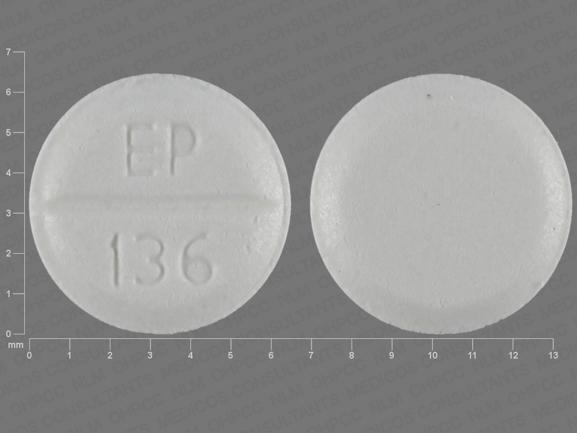Benztropine Dosage
Medically reviewed by Drugs.com. Last updated on Aug 3, 2023.
Applies to the following strengths: 0.5 mg; 2 mg; 1 mg; 1 mg/mL
Usual Adult Dose for:
Usual Pediatric Dose for:
Additional dosage information:
Usual Adult Dose for Extrapyramidal Reaction
Acute dystonic reaction:
Initial: 1 to 2 mg IM/IV once followed by 1 to 2 mg orally twice a day
Drug-induced Extrapyramidal Disorders
Initial dose: 1 to 2 mg orally or IM/IV 2 to 3 times a day
- Dose adjustments should be made in 0.5 mg increments at 5 to 6 day intervals
Maximum dose: 6 mg per day
Comments:
- May be given IM or IV, but since there is no significant difference in onset of effect between IM and IV administration; IM injections are preferred; oral therapy should be used as soon as patients are able to take oral medications.
- Drug-induced extrapyramidal disorders that develop soon after starting neuroleptic drugs are likely to be transient; after 1 to 2 weeks, this drug should be withdrawn to determine continued need, if extrapyramidal disorders recur, this drug can be restarted.
- Because of cumulative toxicity, the smallest dose necessary for optimal relief without excessive adverse reactions should be used.
- Drug induced extrapyramidal disorders that develop slowly may not respond to this drug.
Use: For the control of extrapyramidal disorders due to neuroleptic drugs.
Usual Adult Dose for Parkinson's Disease
Initial: 0.5 to 2 mg orally or IM/IV once a day
Usual dose: 1 to 2 mg orally per day
Effective dose range: 0.5 to 6 mg per day
Maximum dose: 6 mg per day
Comments:
- May be given IM or IV, but since there is no significant difference in onset of effect between IM and IV administration; IM injections are preferred; oral therapy should be used as soon as patients are able to take oral medications.
- Dose should be individualized; anticholinergics are poorly tolerated in older patients and therefore use caution with large doses in older patients.
- This drug's long duration of action makes it suitable for once daily administration; however some patients will do better with divided doses.
Use: For use as an adjunct in the therapy of all forms of Parkinsonism.
Usual Pediatric Dose for Extrapyramidal Reaction
Less than 3 years: Use is contraindicated
3 years or older: Use with caution in older pediatric patients
Some authorities suggest:
Initial dose: 0.02 to 0.05 mg/kg/dose orally or parenterally 1 or 2 times a day
Maximum dose: 4 mg per day
Adolescents: 1 to 4 mg orally or parenterally in divided doses 1 or 2 times a day
Maximum dose: 4 mg per day
Comments:
- There are no adequate and well controlled studies in pediatric patients; dosage should be individualized based on severity of symptoms and patient characteristics.
- Since there is no significant difference in onset of effect between IM and IV injections; IM injections are preferred; oral therapy should be used as soon as patients are able to take oral medications
- Drug-induced extrapyramidal disorders that develop soon after starting neuroleptic drugs are likely to be transient; after 1 to 2 weeks, this drug should be withdrawn to determine continued need, if extrapyramidal disorders recur, this drug can be restarted.
- Drug induced extrapyramidal disorders that develop slowly may not respond to this drug.
Use: For the control of extrapyramidal disorders due to neuroleptic drugs.
Renal Dose Adjustments
Data not available
Liver Dose Adjustments
Data not available
Dose Adjustments
Elderly patients and those who are thin or underweight generally do not tolerate higher dosages; initial doses should be conservative and titration should be slow and gradual.
Precautions
Safety and efficacy have not been established in patients younger than 3 years.
Consult WARNINGS section for additional precautions.
Dialysis
Data not available
Other Comments
Administration advice:
- May be administered orally or parenterally (IM or IV)
- Since there is no difference in onset of effect after IM or IV administration, IM is preferred
General:
- This drug is ineffective in the treatment of tardive dyskinesia, and should therefore not be used for that indication.
- Elderly patients and those who are thin or underweight generally do not tolerate higher dosage.
- No specific dose recommendations for pediatric patients; however, due to higher incidence of adverse effects in this population, initial doses should be conservative and titration should be slow and gradual.
Monitoring:
- Monitor for anticholinergic toxicity, especially with higher doses.
Patient advice:
- Inform patients that this drug may impair mental and/or physical abilities required to perform hazardous tasks such as driving a motor vehicle.
- Advise patients that they may experience inadequate perspiration while taking this drug; patients should consult a healthcare professional before undertaking manual labor in hot environments.
- Patients should be instructed to check with their healthcare provider before taking any new medications.
More about benztropine
- Check interactions
- Compare alternatives
- Pricing & coupons
- Reviews (36)
- Drug images
- Side effects
- Patient tips
- During pregnancy
- Drug class: anticholinergic antiparkinson agents
- Breastfeeding
- En español
Patient resources
Other brands
Professional resources
Other brands
Related treatment guides
Further information
Always consult your healthcare provider to ensure the information displayed on this page applies to your personal circumstances.


